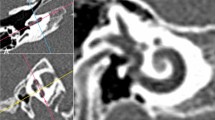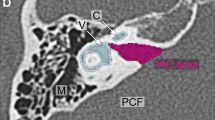Abstract
Background
Radiological investigation is frequently undertaken to assess the aetiology of sensorineural hearing loss (SNHL).
Objective
To establish the CT measurements of the normal cochlea in children and to determine radiological criteria correlated with SNHL.
Materials and methods
A retrospective study of temporal bone CT performed in 159 children, age range from 3 days to 16 years between February 1999 and July 2004. A control group (n = 88) comprised children without SNHL; the SNHL group comprised 71 children. The width of the second turn of the cochlea (CW), the cochlear height (CH), and the width of the bony canal for the cochlear nerve (WCN) were measured on a reference plane containing the modiolus, the posterior semicircular canal, the footplate, and the stapes arch.
Results
Width of the canal measurements ≤1.7 mm or ≥2.5 mm supported the diagnosis of SNHL with a specificity of 97% and 91%, respectively. Cochlear width was found to be significantly smaller in the SNHL group (5.61 ± 0.51 mm) than in the control group (5.75 ± 0.31 mm, P < 0.02), a size <5.4 mm being highly suggestive of SNHL with a specificity of 90%. No significant variations of all measurements were found with age.
Conclusion
Appropriate measurements of WCN and CW are highly correlated with SNHL.







Similar content being viewed by others
References
Westerhof JP, Rademaker J, Weber BP et al (2001) Congenital malformations of the inner ear and the vestibulocochlear nerve in children with sensorineural hearing loss: evaluation with CT and MRI. J Comput Assist Tomogr 25:719–726
Bamiou DE, Savy L, O’Mahoney C et al (1999) Unilateral sensorineural hearing loss and its aetiology in childhood: the contribution of computerised tomography in aetiological diagnosis and management. Int J Pediatr Otorhinolaryngol 51:91–99
Fatterpekar GM, Mukherji SK, Alley J et al (2000) Hypoplasia of the bony canal for the cochlear nerve in patients with congenital sensorineural hearing loss: initial observations. Radiology 215:243–246
Purcell D, Johnson J, Fischbein N et al (2003) Establishment of normative cochlear and vestibular measurements to aid in the diagnosis of inner ear malformations. Otolaryngol Head Neck Surg 128:78–87
Purcell DD, Fischbein N, Lalwani AK (2003) Identification of previously “undetectable” abnormalities of the bony labyrinth with computed tomography measurement. Laryngoscope 113:1908–1911
Birman CS, Gibson WP (1999) Hearing loss associated with large internal auditory meatus: a report of five paediatric cases. J Laryngol Otol 113:1015–1019
Stjernholm C, Muren C (2002) Dimensions of the cochlear nerve canal: a radioanatomic investigation. Acta Otolaryngol 122:43–48
Stjernholm C (2003) Aspects of temporal bone anatomy and pathology in conjunction with cochlear implant surgery. Acta Radiol Suppl. 430:2–15
McClay JE, Tandy R, Grundfast K et al (2002) Major and minor temporal bone abnormalities in children with and without congenital sensorineural hearing loss. Arch Otolaryngol Head Neck Surg 128:664–671
Bamiou DE, Phelps P, Sirimanna T (2000) Temporal bone computed tomography findings in bilateral sensorineural hearing loss. Arch Dis Child 82:257–260
Casselman JW, Offeciers FE, Govaerts PJ et al (1997) Aplasia and hypoplasia of the vestibulocochlear nerve: diagnosis with MR imaging. Radiology 202:773–781
Sakashita T, Sando I (1995) Postnatal development of the internal auditory canal studied by computer-aided three-dimensional reconstruction and measurement. Ann Otol Rhinol Laryngol 104:469–475
Chen JL, Gittleman A, Barnes PD et al (2008) Utility of temporal bone computed tomographic measurements in the evaluation of inner ear malformations. Arch Otolaryngol Head Neck Surg 134:50–56
Purcell DD, Fischbein NJ, Patel A et al (2006) Two temporal bone computed tomography measurements increase recognition of malformations and predict sensorineural hearing loss. Laryngoscope 116:1439–1446
O’Leary SJ, Gibson WP (1999) Surviving cochlear function in the presence of auditory nerve agenesis. J Laryngol Otol 113:1008–1010
Van de Water TR (1988) Tissue interactions and cell differentiation: neurone-sensory cell interaction during otic development. Development 103 Suppl:185–193
Nelson EG, Hinojosa R (2001) Aplasia of the cochlear nerve: a temporal bone study. Otol Neurotol 22:790–795
Lemmerling MM, Mancuso AA, Antonelli PJ et al (1997) Normal modiolus: CT appearance in patients with a large vestibular aqueduct. Radiology 204:213–219
Naganawa S, Ito T, Iwayama E et al (1999) MR imaging of the cochlear modiolus: area measurement in healthy subjects and in patients with a large endolymphatic duct and sac. Radiology 213:819–823
Naganawa S, Koshikawa T, Iwayama E et al (2000) MR imaging of the enlarged endolymphatic duct and sac syndrome by use of a 3D fast asymmetric spin-echo sequence: volume and signal-intensity measurement of the endolymphatic duct and sac and area measurement of the cochlear modiolus. AJNR 21:1664–1669
Antonelli PJ, Varela AE, Mancuso AA (1999) Diagnostic yield of high-resolution computed tomography for pediatric sensorineural hearing loss. Laryngoscope 109:1642–1647
Woolley AL, Oser AB, Lusk RP et al (1997) Preoperative temporal bone computed tomography scan and its use in evaluating the pediatric cochlear implant candidate. Laryngoscope 107:1100–1106
Gray RF, Ray J, Baguley DM et al (1998) Cochlear implant failure due to unexpected absence of the eighth nerve—a cautionary tale. J Laryngol Otol 112:646–649
Rothschild MA, Wackym PA, Silvers AR et al (1999) Isolated primary unilateral stenosis of the internal auditory canal. Int J Pediatr Otorhinolaryngol 50:219–224
Furuta S, Ogura M, Higano S et al (2000) Reduced size of the cochlear branch of the vestibulocochlear nerve in a child with sensorineural hearing loss. AJNR 21:328–330
Nishizaki K, Yuen K, Akagi H et al (1999) Imaging case of the month: bilateral empty internal auditory canal. Am J Otol 20:91–92
Author information
Authors and Affiliations
Corresponding author
Rights and permissions
About this article
Cite this article
Teissier, N., Van Den Abbeele, T., Sebag, G. et al. Computed tomography measurements of the normal and the pathologic cochlea in children. Pediatr Radiol 40, 275–283 (2010). https://doi.org/10.1007/s00247-009-1423-2
Received:
Revised:
Accepted:
Published:
Issue Date:
DOI: https://doi.org/10.1007/s00247-009-1423-2




